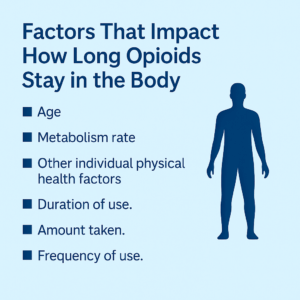How Long Do Opioids Stay In Your System?
Opioids are a class of drugs often used to relieve pain. “Opioid” is an umbrella term that includes natural opioids, semi-synthetic opioids derived from natural opioids, and synthetic opioids created in a laboratory. Opioid drugs are a group of drugs that includes opiates, which are natural derivatives of the poppy plant. The main difference is that “opiate” refers specifically to the substances derived from the opium (poppy) plant, while “opioids” are all substances that interact with the opioid receptors including those created in the lab.
Several naturally occurring opiate alkaloids—such as morphine, codeine, and thebaine—serve as the chemical building blocks of many semi-synthetic opioid drugs, including heroin, oxycodone, and hydrocodone.
Many opioids are essential in the medical community for their sedative and painkilling properties, though heroin is a morphine derivative that’s illegal. All of these drugs have a high addiction potential, and even those that are given out legally via prescription are often misused.
Factors That Affect Drug Processing
 Various factors affect how quickly an opioid leaves the system, including:
Various factors affect how quickly an opioid leaves the system, including:
- Duration of use.
- Amount taken.
- Frequency of use.
- Individual physical health factors (e.g., age, rate of metabolism, etc.).
How Long Do Opioids Stay In Your System?
Many opioids tend to have short half-lives, meaning that they leave the system quickly, though effects can last for several hours. How long each opioid can be detected by drug tests varies depending on the aforementioned factors as well as the method of use. When taken orally, the substance must pass through the digestive system first, so its effects are less immediate. On the other hand, some opioids are injected, smoked, or snorted. These methods create a much faster effect, and they pass out of the body sooner.
Thus, it’s important to speak with a healthcare professional to determine exactly how long an opioid will remain in your system based on your unique variables.
How Long Does Heroin Stay in Your System?
Heroin is a particularly fast-acting drug with a very short half-life. While saliva, blood, and urine tests are often used to detect heroin use, the length of time heroin stays in your system depends on the aforementioned variables.
How Long Does Hydrocodone Stay in Your System?
Hydrocodone often leaves the body faster than heroin. But given the variables, it’s important to speak with a healthcare provider to asses your unique health and use factors and their impact on substance elimination and metabolism.
How Long Does Morphine Stay in Your System?
Depending on the method of use, morphine may take longer to produce effects than heroin. While blood, saliva, and urine tests can detect the substance, hair tests are also used to detect the substance over much longer periods.
How Long Does Codeine Stay in Your System?
Codeine is similar to other opioids in that a host of variables dramatically affect the amount of time it takes for the body to eliminate the substance. Once again, healthcare providers can assist you in determining how your individual factors affect your metabolism and substance elimination.
How Long Does Oxycodone (Oxycontin) Stay in Your System?
The half-life of oxycodone is 3-5 hours. Oxycodone is primarily metabolized by the liver. This process produces metabolites, the most common of which is noroxycodone, followed by noroxymorphone. Oxycodone and its metabolites are excreted through the kidneys.
But like most other opioids, oxycodone can be detected in hair samples longer than it can in blood, urine, or saliva. The length of time the substance remains in your system is once again impacted by a host of variables.
How Long Do Poppy Seeds Stay in Your System?
Can eating a poppy seed muffin or bagel before a drug test create false positive? The answer depends on the test. Poppy seeds contain low levels of opiates, and older tests may have show false positive results based on poppy seed ingestion. However, testing guidelines have improved and it’s less likely to be flagged for opiate use after eating poppy seed-containing foods.
Find Prescription Drug Treatment Near You
